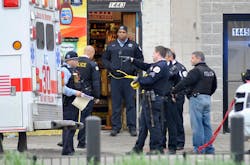Chicago Homicides Up 60% So Far in 2012
Homicides in Chicago soared by 60 percent in the first three months of 2012, continuing a troublesome trend that began late last year. Nonfatal shootings also rose sharply in the first quarter, Police Department statistics show.
The worsening violence comes as the Emanuel administration touts its efforts to combat gang crime and add officers and resources to some of the city's most dangerous neighborhoods.
Chicago police blame street gangs for much of the violence. Another contributing factor for the rise in homicides was the unseasonably warm weather this past winter, according to criminologists, but Chicago police Superintendent Garry McCarthy scoffed at that explanation earlier this year.
"In better weather, people are outside more, interacting more with neighbors, acquaintances, even strangers, and there's greater opportunity for conflict than when it's cold and windy," said James Alan Fox, a professor of criminology, law and public policy at Northeastern University in Boston.
Fox and other experts caution that concluding too much from a few months of crime statistics can be misleading and noted that in recent years Chicago has been at historic lows for homicides. But in 2008, the city saw similar spikes early in the year and ended up with more than 500 homicides, the only time that has happened in the last nine years.
From Jan. 1 through April 1 this year, 120 homicides were recorded in Chicago, up sharply from 75 in the same period in both 2011 and 2010, according to department statistics. Nonfatal shootings totaled almost 490 in the first three months of 2012, up 37 percent from a year earlier.
Crime in every other major category fell, including a 15 percent drop in sexual assaults and a 10 percent decline in burglaries. Overall crime dropped 10 percent citywide, according to the department.
To combat violence in two of Chicago's most violent neighborhoods, McCarthy saturated "conflict zones" in the Englewood and Harrison police districts with additional officers early this year as a long-term strategy.
But the early results appear mixed. Through April 1, homicides fell to six in the Harrison District on the West Side, down from nine a year earlier. But killings almost doubled in the Englewood District on the South Side, jumping to 15 from eight. Nonfatal shootings rose sharply in both districts, however.
Homicides were also up sharply in the Ogden and Chicago Lawn police districts, the statistics show.
In mid-January, McCarthy trumpeted that Chicago had gone 24 hours without a single homicide or shooting. But by near the end of the month, killings had risen 54 percent. At the time, McCarthy expressed confidence that homicides would go down when shootings fell. At that point, the number of shootings was the same as in 2011. But since the beginning of 2012, nonfatal shootings have risen by more than a third.
During one particularly violent weekend last month, 49 people were shot -- 10 of them fatally, including a 6-year-old girl as she sat between her mom's legs on the family's Little Village front porch. The violence was largely concentrated on the South and Southwest sides.
In the last two weeks of March, the violence continued unabated. The department's statistics show that 26 people were killed and more than 80 nonfatal shootings occurred from March 19 through April 1.
At the end of March, McCarthy reshuffled his command staff, replacing commanders in five of the city's 23 districts.
"We took a pretty big hit for the first quarter of this year," Bob Tracy, chief of the department's crime control strategies, acknowledged in a telephone interview Wednesday.
Tracy said a lot of retaliatory shootings among "some of our younger gang members" contributed to the spike.
Tracy insisted that keeping officers on beat patrols will prove more effective in the long run than having cops work in specialized units like the now-defunct Mobile Strike Force. The department is making strides in ensuring that its beat officers and citywide gang units work more closely together to determine where gang conflicts exist and identify their main players, he said.
"We're making sure the intelligence is in the hands of the officers," Tracy said. "As we keep our plan going, I think in the long run you're going to start seeing a decline in the violence."
The president of the Fraternal Order of Police, the union that represents rank-and-file cops, continued to blame the rising violence on the department's failure to replace retiring officers.
"Any officer will tell you that the Chicago Police Department is short-staffed, except for the superintendent," said Michael Shields. "This year's budget was balanced at the expense of public safety."
Copyright 2012 - Chicago Tribune
McClatchy-Tribune News Service
